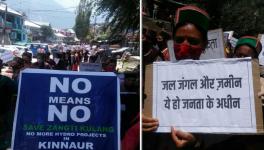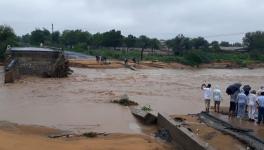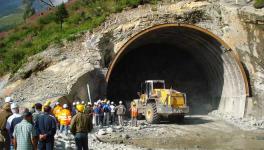Why Rohtang Tunnel Can Turn From Boon to Bane for Lahaul’s People and Ecology

Image Courtesy: Republic World
On October 3, the Rohtang tunnel was inaugurated by the Prime Minister in Manali. There was the usual euphoria on the part of both the Central and state governments which took credit for the construction and commissioning of this project.
In another column, this author had mentioned the evolution of the Border Roads Organisation which had eventually also led to the idea of a tunnel from Manali to the Northern part of the Pir Panjal range towards Keylong, the capital of Lahaul and Spiti district in Himachal Pradesh.
This article intends to highlight the challenges that the people and ecology of the region will face once a large numbers of cars and tourists throng the district, which otherwise remained closed for almost six months, but because of the tunnel will now be accessible throughout the year.
There are already reports in sections of the press highlighting the immediate impact of the tunnel on the environment in Lahaul. Tourists visiting the valley and throwing trash all around is a common picture. Local residents have also reported incidents of tourists stealing potato sacks kept for transportation to the market along the road. It is pertinent to mention here that traditionally most of the houses remain unlocked in the Lahaul and Spiti valley even when they go out to the fields or move out to Kullu.
More tourists thronging the Lahaul valley, thanks to the new tunnel, can be perilous if proper planning is not done right now. In fact, before the inauguration of the tunnel, the state government should have initiated a dialogue with experts, elected representatives and common people to lay out a sustainable development plan for tourism for the Lahaul and Spiti valley.
Any sustainable tourism plan must encompass three important aspects while ensuring that it is made in a participatory way. These are: ecology and environment; economic development and socially inclusion.
Unfortunately, the Himachal Pradesh government, both the present and the previous ones, did not pay any heed to such a vision and did not contemplate the adverse impact that a thoroughfare through the tunnel would have. Actually, work on such a plan should have begun the day the runnel’s construction started in 2010. Now, all that the government is doing is some piecemeal intervention, which will not serve any purpose in resolving the anticipated problems.
The population of Lahaul and Spiti valley is only 31,564. according to the 2011 Census. But it is one of the largest geographic districts of India with a density of two persons per square kilometre. An equal number or perhaps more would be flooding the district daily in peak days. But, there is no plan on how the lodging of such a large number of tourists will be taken care of, how will solid and liquid waste be managed, who will be the beneficiaries of such a large number of people entering the district etc.?
Readers may note that nearly 20 million tourists, foreign and domestic, visit Himachal Pradesh every year, whereas the population of the state is nearly 6.8 million. With the opening of Lahaul and Spiti, there will be a larger influx of tourists but without any commensurate development of basic infrastructure to handle such a large inflow. The precarious future can well be imagined.
For example, as the new Rohtang tunnel (Atal tunnel) enters the North portal in Lahaul, there is not a single toilet from that end to the capital of the district, Leh, which is nearly 37 km away.
According to reports, within 12 days of the tunnel’s opening after October 3, there was not just littering all around the rivers Chander and Bhaga, which eventually become Chenab in Kashmir, but open defecation along the road could be seen.
Stealing apples and potato bags were also reported. Also, something unheard of – incidents of teasing of tribal women have been reported by local residents.
The state government’s department of environment has said that would install dustbins to ensure that tourists do not litter around. This is just a piecemeal step, as there is still no plan on who will take the call on solid waste management, who will clear these bins and how such waste will be treated?
NEITHER LEH NOR THIMPU MODEL
Both the Leh and Thimpu models may not work for Lahaul. There are many reasons for this. Take the example of Leh, the capital of Ladakh, which is on the brink of a serious ecological crisis. Since this author is associated with the vision document for Leh and has been regularly engaged in the planning process, all that can be said is that Leh holds a lesson for Lahaul to not go the same way. This is why.
First, the native population of Leh did not realise that the priceless wealth that they have is water. The water that used to flow from the glacier was not just adequate to suffice for the year but was even potable. People also had groundwater.
But, with the changing paradigm of tourism in Leh, most houses got converted into guest houses and hotels and changed their toilet system from the conventional ‘dry’ to ‘wet’ toilets. This one single intervention led to contamination of almost 95% of underground water, and the glacial water flowing into the town is now raw sewage.
Second, with the massive inflow of tourists, solid waste management was a real disaster. One of the valleys in Leh town has been converted into a waste site, which is a nightmare.
Third, mobility in the town is in shatters. Despite the fact that the average radius of a commute is not even one kilometre for residents, there is immense pressure of traffic, and something unheard of -- pollution -- is now being witnessed in Leh town.
Fourth, in the absence of affirmative policies and intervention, most of the money generated through tourism-related activities is parked outside Leh, not within the valley. So, the region and its people, by and large, are not the key beneficiaries of rising tourism in the absence of a planned sustainable developmental model. Though some interventions are now being made, due to the changed political climate, one is not sure what and when the results of these changes will be witnessed.
Thimpu, the capital of Bhutan, is another model that cannot be eulogised by Lahaul residents. The foremost reason is that Lahaul is not a sovereign region where sweeping laws can be enforced on the people.
Second, Thimpu works with the logic of ‘better few, but better’. Probably, application of this dictum may not be possible in Lahaul. Nevertheless, the experience of Bhutan in managing the tourism flow must be applied with concrete conditions in Lahaul.
WHAT NEEDS TO BE DONE?
First and foremost, the state government must form a team at the state-level to work on a sustainable development model of tourism for Lahaul and Spiti. This team must not be limited to another ‘bureaucrat-centric report generating’ exercise, rather it should form a wide coalition of practitioners, urban development experts, ecologists, hydrologists, local residents, elected representatives of the district, at the least.
This team must prepare a report in a time-bound manner and an action plan must be drawn with performance-based results.
Third, the local residents must be part of the larger beneficiaries of the tourist influx. The shift in profile from agriculturists to tourism, which is bound to happen, must serve the local people first.
Fourth, the proposed tourism model must also work out a solid and liquid waste management plan for the district. Since the geographical area is huge, one cannot imagine centralised plants for both. Rather, the focus should be on decentralised waste management with easy and cheap solutions.
Fifth, new construction in the hospitality sector, that is bound to proliferate, must be regularised. The proposed plan must specify how and where such structures should come up. Even the architectural plan must be discussed before allowing such structures to come up.
Water must be the foremost priority while preparing a sustainable plan for the district, which must ensure that not a drop of untreated wastewater enters the rivulets and rivers in the district. Else, the situation could be worse than Leh.
Regulation of the total number of visitors entering Lahaul valley is not a bad idea, too. Daily permits should be issued on the total number of desired visitors. Simultaneously, a green fee should be charged from tourists entering the Lahaul valley and this fee should vest with local bodies or a regulatory body that must be created to manage tourism affairs in the valley.
Else, a few years down the line, the tunnel, which is a boon for residents of Lahaul valley, as it shall integrate them to the market and the mainland throughout the year, shall become a bane with irreversible changes in their ecology, environment and behaviour.
The writer is former Deputy Mayor of Shimla, Himachal Pradesh. The views are personal.
Get the latest reports & analysis with people's perspective on Protests, movements & deep analytical videos, discussions of the current affairs in your Telegram app. Subscribe to NewsClick's Telegram channel & get Real-Time updates on stories, as they get published on our website.


















